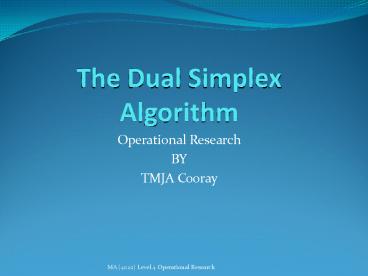The Dual Simplex Algorithm - PowerPoint PPT Presentation
1 / 10
Title:
The Dual Simplex Algorithm
Description:
The simplex method starts with a dictionary which is feasible but does not ... variables , we perform the normal pivot operation to move to the next dictionary. ... – PowerPoint PPT presentation
Number of Views:752
Avg rating:3.0/5.0
Title: The Dual Simplex Algorithm
1
The Dual Simplex Algorithm
- Operational Research
- BY
- TMJA Cooray
2
Introduction
- The simplex method starts with a dictionary which
is feasible but does not satisfy the optimality
condition on the Z equation. It then performs
successive pivot operations , preserving
feasibility , to find a dictionary which is both
feasible and optimal.?
3
- The dual simplex algorithm starts with a
dictionary which satisfies the optimality
condition on the z- equation, but is not
feasible. - It then performs successive pivot operations,
which preserve optimality, to find a dictionary
which is both feasible and optimal.
This Dual simplex method is very useful in
sensitivity analysis and also in solving Integer
programming problems.
4
Method
- Feasibility condition variable having the most
negative value. (break ties arbitrarily) - Optimality condition find the ratios of the
coefficients of the objective row and the leaving
variable row.
5
Method
- Leaving variable basic variable having the most
negative value. (break ties arbitrarily) - .
- Entering variable non basic variable with the
smallest absolute ratio , that is min Zj/aij
such that aij lt 0. - if all the denominators are 0 or ve , the
problem has no feasible solution. (Can not get
rid of infeasibility.)
6
- Once we have identified the leaving and the
entering variables , we perform the normal pivot
operation to move to the next dictionary.
7
- Min Zy60Y140Y2
- Subject to 5Y14Y2? 6,
- 10Y14Y2? 8
- Y1,Y2? 0
- -5Y1-4Y2s1 - 6,
- -10Y1-4Y2s2- 8
Ratio -6 -10
Smallest absolute value
8
-8
-12
Smallest absolute value
9
The optimal solution
This is a feasible solution and still optimal
. Stop the procedure.
10
Exercise































